module 32 Modern Large-Scale Farming Methods
Modern agricultural methods are widespread throughout the developed world. They involve efficient, large-
Learning Objectives
After reading this module you should be able to
describe modern, large-
scale agricultural methods. explain the benefits and consequences of genetically modified organisms.
discuss the large-
scale raising of meat and fish.
Modern industrial farming methods have transformed agriculture
The advent of agriculture roughly 10,000 years ago enabled people to move beyond a subsistence level of existence. At the same time, it did have some negative consequences. Deliberate cultivation of food also initiated a level of environmental degradation never before experienced on Earth. The abundance of food supplied by agriculture is also one factor that has led to the exponential growth of the human population. An increase in food production leads to a positive feedback loop: With more food come more people, who require even more food production.
Industrial agriculture Agriculture that applies the techniques of mechanization and standardization. Also known as agribusiness.
In the twentieth century, farming became more mechanized, and the use of fossil fuel energy in food production increased. These changes have led to increasing food output as well as a variety of environmental impacts. Industrial agriculture, or agribusiness, applies the techniques of the Industrial Revolution—
The Energy Subsidy in Agriculture
Energy subsidy The fossil fuel energy and human energy input per calorie of food produced.
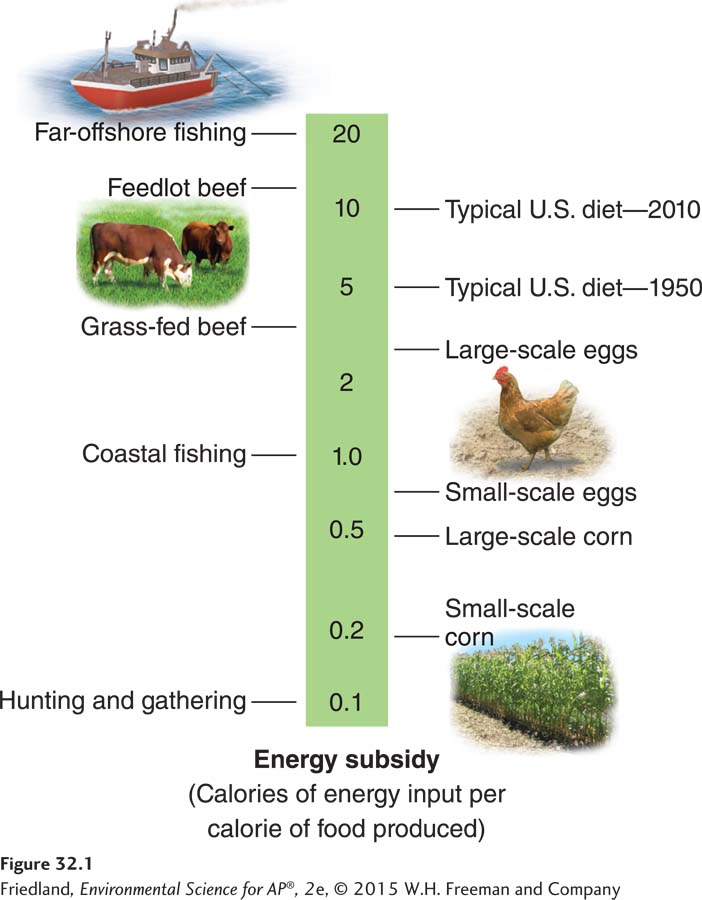
The activities associated with growing, harvesting, processing, and preparing food require a great deal of energy input beyond solar energy. The fossil fuel energy and human energy input per calorie of food produced is called the energy subsidy. In other words, if we use 5 calories of human and fossil fuel energy to produce food, and we receive 1 calorie of energy when we eat that food, then the food has an energy subsidy of 5. We can think of this in another way if we use mass of inputs and outputs as a substitute measure for energy. If it takes 20 kg (44 pounds) of grain to feed to cattle to produce 1 kg (2.2 pounds) of beef, the energy subsidy is 20. If it takes 2.8 kg (6 pounds) of grain to feed to chickens to produce 1 kg (2.2 pounds) of chicken meat, the energy subsidy is 2.8, which is considerably smaller than the energy subsidy for beef. The comparison is not perfect, because the energy content of 1 kg of beef is greater than that of 1 kg of grain. Nevertheless, it should help you to understand the relationship between energy inputs and outputs in producing food.
As FIGURE 32.1 shows, traditional small-
“Do the Math: Land Needed for Food” shows you how to calculate the different land requirements for obtaining sufficient calories from corn and from beef.
Most of the energy subsidies in modern agriculture are in the form of fossil fuels, which are used to produce fertilizers and pesticides, to operate tractors, to pump water for irrigation, and to harvest food and prepare it for transport. Other energy subsidies take place off the farm. For example, the average food item travels 2,000 km (1,240 miles) from the farm to your plate, so we often spend far more energy on transporting food than we get from the food itself. The Department of Energy reports that in the United States, 17 percent of total commercial energy use goes into growing, processing, transporting, and cooking food. Those of us eating a supermarket diet in the developed world are highly dependent on fossil fuel for our food; the modern agricultural system would not work without it.
The Green Revolution
Green Revolution A shift in agricultural practices in the twentieth century that included new management techniques, mechanization, fertilization, irrigation, and improved crop varieties, and that resulted in increased food output.
How did we get to our current levels of energy use for food production? In the twentieth century, the agricultural system was dramatically transformed from a system of small farms relying mainly on human labor with relatively low fossil fuel inputs to a system of large industrial operations with fewer people but much more machinery. This shift in farming methods, known as the Green Revolution, involved new management techniques and mechanization as well as the triad of fertilization, irrigation, and improved crop varieties. These changes increased food production dramatically, and farmers were able to feed many more people.
The Green Revolution began with the work of crop scientists, particularly the American scientist Norman Borlaug (1914–
The upward trend in world grain production since 1950 (see FIGURE 31.3a) is the result of the Green Revolution. From the mid-
Mechanization
Farming involves many kinds of work. Fields must be plowed, planted, irrigated, weeded, protected from pests, harvested, and prepared for the next season. Even after harvesting, crops must be dried, sorted, cleaned, and prepared for market in almost as many different ways as there are different crops. Machines do not necessarily do this work better than humans or animals, but it can be economically advantageous to replace humans or animals with machinery, particularly if fossil fuels are abundant, fuel prices are relatively low, and labor prices are relatively high. In developed countries, where wages are relatively high, less than 5 percent of the workforce works in agriculture. In developing countries, where wages tend to be much lower, 40 to 75 percent of the working population is employed in agriculture.
Economies of scale The observation that average costs of production fall as output increases.
Since the advent of mechanization, large farms producing staple crops such as beans or corn have generally been more profitable than small farms. Size matters because of economies of scale, which means that the average costs of production fall as output increases. For example, a new combine harvester—
Mechanization also means that single-
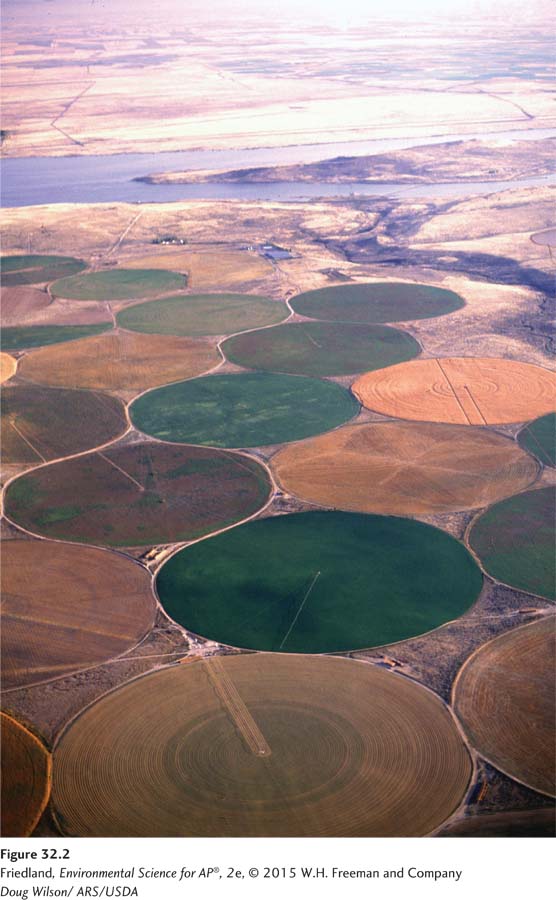
Irrigation
Irrigation systems like those described in Chapter 9 can increase crop growth rates or even enable crops to grow where they could not otherwise be grown (FIGURE 32.2). For example, irrigation has transformed approximately 400,000 ha (1 million acres) of former desert in the Imperial Valley of southeastern California into a major producer of fruits and vegetables. In other situations, irrigation can allow productive land to become extremely productive land. One estimate suggests that the 16 percent of the world’s agricultural land that is irrigated produces 40 percent of the world’s food.
Waterlogging A form of soil degradation that occurs when soil remains under water for prolonged periods.
Salinization A form of soil degradation that occurs when the small amount of salts in irrigation water becomes highly concentrated on the soil surface through evaporation.
While irrigation has many benefits, including more efficient use of water in some places where it is scarce, it can also have a number of negative consequences over time. As we saw in Chapter 9, it can deplete groundwater, draw down aquifers, and cause saltwater intrusion into freshwater wells. It can also contribute to soil degradation through waterlogging and salinization, shown in FIGURE 32.3. Waterlogging, a form of soil degradation that occurs when soil remains under water for prolonged periods, impairs root growth because roots cannot get oxygen. Salinization occurs when the small amounts of salts in irrigation water become highly concentrated on the soil surface through evaporation. These salts can eventually reach toxic levels and impede plant growth.

Fertilizers
Agriculture removes organic matter and nutrients from soil, and if these materials are not replenished, they can be quickly depleted. Industrial agriculture, because it keeps soil in constant production, requires large amounts of fertilizers to replace lost organic matter and nutrients. Fertilizers contain essential nutrients for plants—
Organic fertilizer Fertilizer composed of organic matter from plants and animals.
As their name suggests, organic fertilizers are composed of organic matter from plants and animals. They are typically made up of animal manure that has been allowed to decompose. Traditional farmers often spread animal manure and crop wastes onto fields to return some of the nutrients that were removed from those fields when crops were harvested.
Synthetic fertilizer Fertilizer produced commercially, normally with the use of fossil fuels. Also known as inorganic fertilizer.
Synthetic fertilizers, or inorganic fertilizers, are produced commercially, normally with the use of fossil fuels. Nitrogen fertilizers are often produced by combusting natural gas, which allows nitrogen from the atmosphere to be fixed and captured in fertilizer. Fertilizers produced in this way are highly concentrated, and their widespread use has increased crop yields tremendously since the Green Revolution began. Synthetic fertilizers have many advantages over organic fertilizers. They are designed for easy application, their nutrient content can be targeted to the needs of a particular crop or soil, and plants can easily absorb them, even in poor soils. Worldwide, synthetic fertilizer use increased from 20 million metric tons in 1960 to nearly 200 million metric tons in 2011. It can be argued that without synthetic fertilizers, we could not feed all the people in the world.
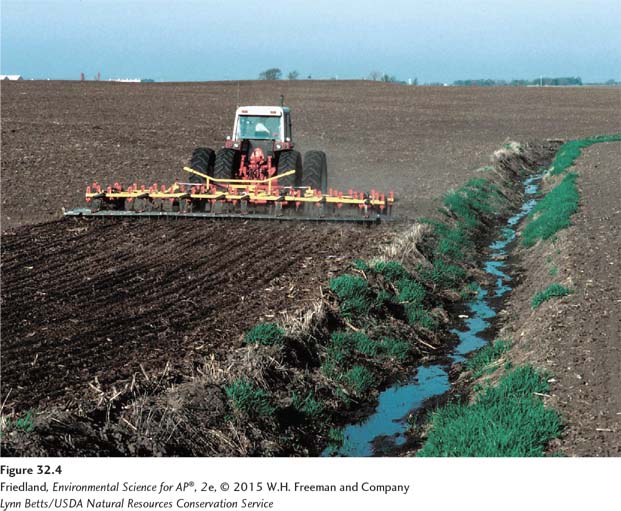
Despite these advantages, synthetic fertilizers can have several adverse effects on the environment. The process of manufacturing synthetic fertilizers uses large quantities of fossil fuel energy. Producing nitrogen fertilizer is an especially energy-
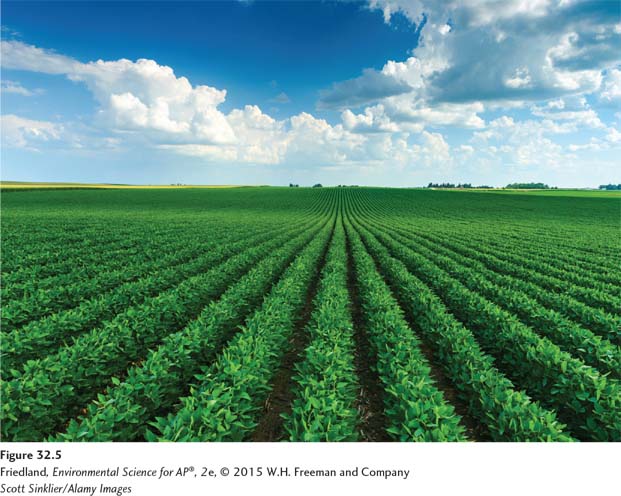
The United States uses somewhat less fertilizer and consequently experiences less nutrient runoff than other nations with similar agricultural output. Still, large amounts of nitrogen and other nutrients run into waterways in intensively farmed regions such as California’s Central Valley, farming regions along the East Coast, and the Mississippi River watershed (FIGURE 32.4).
Monocropping
Monocropping An agricultural method that utilizes large plantings of a single species or variety.
Both the mechanization of agriculture and the use of synthetic fertilizers encourage large plantings of a single species or variety, a practice known as monocropping (FIGURE 32.5). Monocropping is the dominant agricultural practice in the United States, where wheat and cotton are frequently grown in monocrops of 405 ha (1,000 acres) or more.
Monocropping has greatly improved agricultural productivity. This technique allows large expanses of land to be planted and then harvested, all at the same time. With the use of large machinery, the harvest can be done easily and efficiently. If fertilizer or pesticide treatments are required, those treatments can also be applied uniformly over large fields, which, because they are planted with the same crop, have the same pesticide or nutritional needs.
Despite the benefits of increased efficiency and productivity, monocropping can lead to environmental degradation. First, soil erosion can become a problem. Because fields that are monocropped are readied for planting or harvesting all at once, soil will be exposed over many hectares at the same time. On a 405-
Monocropping also makes crops more vulnerable to attack by pests. Large expanses of a single plant species represent a vast food supply for any pests that specialize on that particular plant. Such pests will establish themselves in the monocrop and reproduce rapidly. Their populations may experience exponential growth similar to what we saw in Georgii Gause’s Paramecium populations that were supplied with unlimited food (see FIGURE 18.3 on page 195). Natural predators may not be able to respond rapidly to the exploding pest population. Many predators of crop pests, such as ladybugs and parasitic wasps, are attracted to the pests that feed on monocrops. But these predators also rely on non-
Pesticides
Pesticide A substance, either natural or synthetic, that kills or controls organisms that people consider pests.
Pesticides are substances, either natural or synthetic, that kill or control organisms that people consider pests. The use of pesticides has become routine and widespread in modern industrial agriculture. In the United States, over 227 million kilograms (500 million pounds) of pesticides are applied to food crops, cotton, and fruit trees. The United States accounts for about one-
Insecticide A pesticide that targets species of insects and other invertebrates that consume crops.
Herbicide A pesticide that targets plant species that compete with crops.
Broad-
Selective pesticide A pesticide that targets a narrow range of organisms.
Insecticides target species of insects and other invertebrates that consume crops, and herbicides target plant species that compete with crops. Some pesticides are broad-
The application of pesticides is a rapid and relatively easy response to an infestation of pests on an agricultural crop. In many cases, a single application can significantly reduce a pest population. By preventing crop damage, pesticides allow greater crop yields on less land, thereby reducing the area disturbed by agriculture and making agriculture more efficient.
Persistent pesticide A pesticide that remains in the environment for a long time.
But the application of pesticides, like many other industrial agricultural practices, presents some environmental problems. For example, pesticides often injure or kill more than their intended targets. Some pesticides, such as dichlorodiphenyltrichloroethane, also known as DDT, are persistent pesticides, meaning that they remain in the environment for a long time. In 1972, DDT was banned in the United States, in part because it was found to accumulate in the fatty tissues of animals, such as eagles and pelicans. The increasing concentrations of DDT in these animals caused them to lay eggs with thin shells that easily cracked during incubation by the parents. We will discuss this process in more detail in Chapter 17.
Nonpersistent pesticide A pesticide that breaks down rapidly, usually in weeks or months.
Other pesticides, such as the herbicide glyphosate, known by the trade name Roundup, are nonpersistent pesticides, meaning that they break down relatively rapidly, usually in weeks to months. Nonpersistent pesticides have fewer long-
Pesticide resistance A trait possessed by certain individuals that are exposed to a pesticide and survive.
Pesticide treadmill A cycle of pesticide development, followed by pest resistance, followed by new pesticide development.
Another disadvantage of pesticide use is that pest populations may evolve resistance to pesticides over time, as described in Chapter 5. Pest populations are usually large and thus contain significant genetic diversity. In those vast gene pools, there are usually a few individuals that are not as susceptible to a pesticide as others, and those individuals may survive an initial application of the pesticide. Surviving individuals are said to be pesticide resistant to that pesticide. If the pesticide is successful in reducing the pest population, the next generation will contain a larger fraction of pesticide resistant individuals in the population. As time goes by, resistant individuals will make up a larger and larger portion of the population. Often the resistance becomes more effective, which makes the pesticide significantly less useful. At this point, crop scientists and farmers must search for a new pesticide. The cycle of pesticide development and pest resistance, illustrated in FIGURE 32.6, is known as the pesticide treadmill. The pesticide treadmill is an example of a positive feedback system.
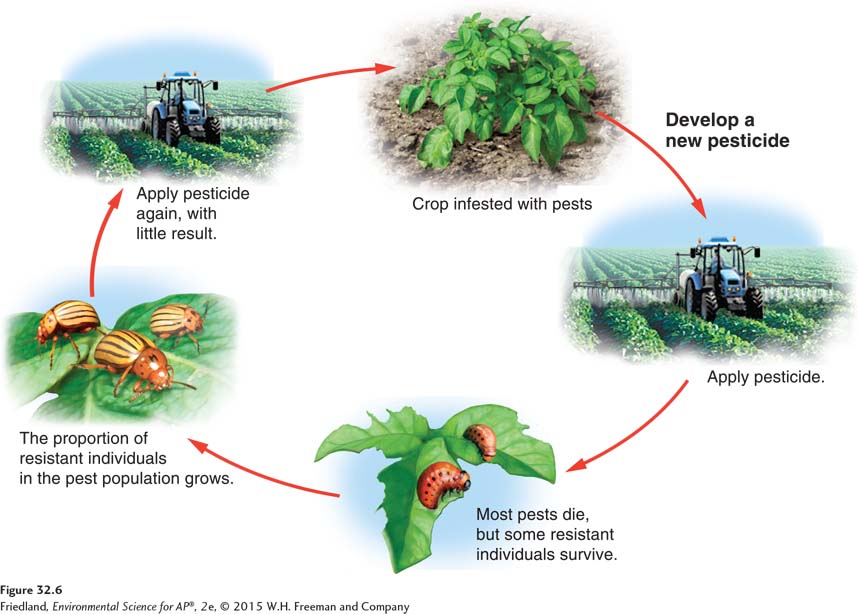
Pesticides can cause even wider environmental effects. They may kill organisms that benefit farmers, such as predatory insects that eat crop pests, pollinator insects that pollinate crop plants, and plants that fix nitrogen and improve soil fertility. Furthermore, chemical pesticides, like fertilizers, can run off into surrounding surface waters and pollute groundwater, a problem we will look at in detail in Chapter 14.The toxicity of pesticides to farmworkers has been well documented. The risk to humans who ingest food that has been treated with pesticides is a subject of debate, which will be covered in Chapter 17.
Genetic engineering is revolutionizing agriculture
As noted in Chapter 5, humans have modified plants and animals by artificial selection for thousands of years. The modern techniques of genetic engineering, however, go far beyond traditional practices. Scientists today can isolate a specific gene from one organism and transfer it into the genetic material of another, often very different, organism to produce a genetically modified organism, or GMO. By manipulating specific genes, agricultural scientists can rapidly produce organisms with desirable traits that may be impossible to develop with traditional breeding techniques. Genetically modified organisms present both benefits and drawbacks.
The Benefits of Genetic Engineering
Genetically modified crops and livestock offer the possibility of greater yield and food quality, reductions in pesticide use, and higher profits for the agribusinesses that use them. They are also seen as a way to help reduce world hunger by increasing food production and reducing losses to pests and varying environmental conditions.
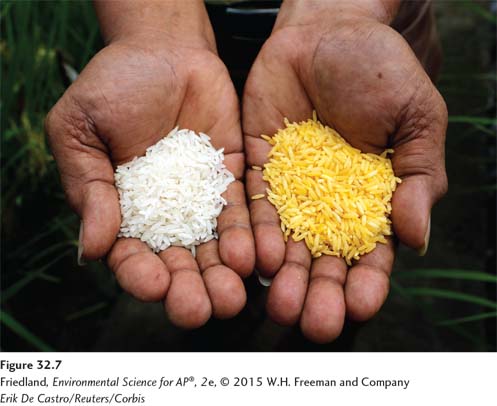
Increased Crop Yield and Quantity
Genetic engineering can increase food production in several ways. It can create strains of organisms that are resistant to pests and harsh environmental conditions such as drought or high salinity. In addition, agricultural scientists have begun to engineer plants that produce essential nutrients for humans. For example, they have inserted a gene for the production of vitamin A into rice plants, creating new seeds known as golden rice (FIGURE 32.7). Although golden rice is still an experimental product, some scientists hope that it will help reduce the incidence of blindness resulting from vitamin A deficiency. Crop plants, animals, and bacteria have also been modified to produce pharmaceuticals and other compounds, a process that can make these products far less expensive to manufacture. A number of projects are under way to create genetically modified animals for food production, including a salmon that grows to its full size of 3.6 kg (8 pounds) in 18 months—
Potential Changes in Pesticide Use
Genetic engineering for resistance to pests could reduce the need for pesticides. Corn, for example, is subject to attacks from the bollworm, European corn borer (Ostrinia nubilalis), and lepidopteran (butterfly and moth) larvae. Bacillus thuringiensis is a natural soil bacterium that produces a toxin that can kill lepidopterans. The insecticidal gene of this bacterium, known as Bt, has been inserted into the genetic material of corn plants, resulting in a genetically modified plant that produces a natural insecticide in its leaves. By 2009, 63 percent of the land area planted with corn in the United States was planted with Bt corn. Growers of Bt corn have been able to reduce the amount of synthetic pesticide used on their corn crops.
A similar technique has been used to create crop plants that are resistant to the herbicide Roundup. The “Roundup Ready” gene allows growers to spray the herbicide on their fields to control the growth of weeds without harming the crop plants. These Bt genes are now widely used in corn, soybean, and cotton plants. The success of no-
Increased Profits
Because pesticides can be a significant expense on any farm, genetically modified crops have the potential to reduce expenses. And because GMO crops often produce greater yields, there is also the potential for an increase in revenues. Both of these changes can lead to higher incomes for farmers, lower food prices for consumers, or both.
Concerns about Genetically Modified Organisms
Industrial agriculture relies more heavily on genetically modified crops each year. In 2012, 88 percent of the corn, 93 percent of the soybeans, and 94 percent of the cotton planted in the United States came from genetically modified seeds. However, many European countries, as well as a number of people in the United States, question the safety of GMOs. Genetically modified crops and livestock are the source of considerable controversy, and concerns have been raised about their safety for human consumption and their effects on biodiversity. Regulation of GMOs is also an issue, both in the United States and abroad.
Safety for Human Consumption
Some people are concerned that the ingestion of genetically modified foods may be harmful to humans, although so far there is little evidence to support these concerns. However, researchers are studying the possibility that GMOs may cause allergic reactions when people eat a food containing genes transferred from another food to which they are allergic.
Effects on Biodiversity
There is some concern that if genetically modified crop plants are able to breed with their wild relatives—
The use of genetically modified seeds is contributing to a loss of genetic diversity among food crops. As with any reduction in biodiversity, we cannot know what beneficial genetic traits might be lost. For example, researchers recently discovered that one variety of sorghum, a cereal grass grown for its sweet juice extract, has a natural genetic variation that gives it resistance to a pest called the greenbug. This particular variety has since been used extensively to confer greenbug resistance on the U.S. sorghum crop. If growers had been growing only one or two genetically modified varieties of sorghum, this naturally resistant variety might have been eliminated before its beneficial trait was discovered.
Regulation of Genetically Modified Organisms
Currently, there are no regulations in the United States that mandate the labeling of genetically modified foods. The European Union, in contrast, allows very few genetically modified foods. In France, Germany, and Italy, almost all GMOs are banned. Those opposed to labeling argue that labeling of foods containing GMOs might suggest to consumers that there is something wrong with GMOs. They also argue that such labeling would be too difficult because small amounts of GMO materials are found throughout the U.S. agricultural system. Those who want to avoid consuming GMOs can safely purchase organic food; the federal definition of “organic” excludes genetically modified foods. (See “Science Applied 5: How Do We Define Organic Food?” on page 392).
The U.S. government has not yet approved any genetically modified animals for market, but there are currently applications for a number of genetically modified animals, most notably salmon, under consideration by the Food and Drug Administration.
Modern agribusiness includes farming meat and fish
We have seen that in order to remain economically viable and feed large numbers of people, modern agriculture in the United States has had to become larger and more mechanized. While many of the goals described in the preceding sections have remained in place as agricultural activities moved to a larger scale, some have been abandoned. In particular, as agriculture developed to supply meat and poultry to large numbers of people at a low cost, the primary goal became faster growth of animals.
High-
Concentrated animal feeding operation (CAFO) A large indoor or outdoor structure designed for maximum output.
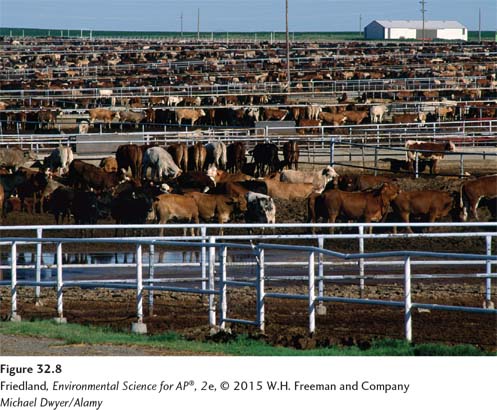
In 2011, according to the U.S. Department of Agriculture, roughly 150 million animals were slaughtered for beef, pork, and lamb, along with billions of chickens, turkeys, and ducks. Many of these animals were raised in feed-
High-
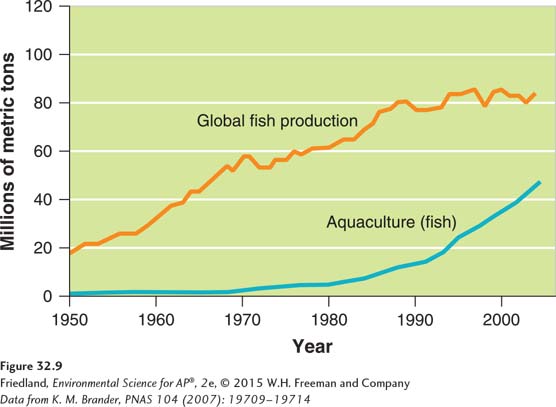
Harvesting Fish and Shellfish
Fish is the third major source of food for humans, after grain and meat. In many coastal areas, particularly in Asia and Africa, fish accounts for nearly all animal protein that some people consume. As FIGURE 32.9 shows, the global production of fish has increased more than 30 percent since 1980.This increase masks two divergent trends: a rapid increase in farmed fish production and a decrease in wild fish caught in the world’s oceans.
Fishery A commercially harvestable population of fish within a particular ecological region.
A fishery is a commercially harvestable population of fish within a particular ecological region. The tragedy of the commons, which we learned about in Chapter 10, is particularly applicable to ocean fisheries. Since most fish do not live their entire lives within national borders, if one individual fisher, or even an entire country, limits its catch, others are likely to make up the difference because those others will not limit their catch. No country has an incentive to protect fish stocks or to attempt to replenish them because fish in the ocean do not belong to any one individual or nation. As a result, competition for fish has led to a precipitous decline in fish populations.
Fishery collapse The decline of a fish population by 90 percent or more.
In 2003, the journal Nature reported a dramatic decline in the number of large predatory ocean fish caught over the past 50 years, even though both the number of fishing vessels and the amount of time spent fishing had increased over that period. Fishers were working harder, but catching fewer fish. A study in 2006 found that 30 percent of fisheries worldwide had experienced a 90 percent decline in fish populations. The decline of a fish population by 90 percent or more is referred to as fishery collapse. Many studies on this subject focus on large predatory fish. However, a 2011 study in the Proceedings of the National Academy of Sciences noted an unexpected increase in fishery collapse among smaller species as well.
Ocean harvests used to be limited by the difficulty of finding fish in a vast ocean as well as by lack of capacity of small boats and nets, but this is no longer the case. Current fishing methods make it easy to catch large numbers of fish. Factory ships can stay at sea for months at a time, processing and freezing their harvest without having to return to port. Most marine fish are now caught either by large nets pulled behind one of these ships or by very long fishing lines bearing hundreds or even thousands of baited hooks. Fishers in pursuit of high-
Bycatch The unintentional catch of nontarget species while fishing.
Large-